TP-Link TL-R488T User Manual

TL-R488T
Load Balance Broadband Router
Rev: 1.1.2
COPYRIGHT & TRADEMARKS
Specifications are subject to change without notice.  ® is a registered trademark of
® is a registered trademark of
TP-LINK TECHNOLOGIES CO., LTD. Other brands and product names are trademarks or registered trademarks of their respective holders.
No part of the specifications may be reproduced in any form or by any means or used to make any derivative such as translation, transformation, or adaptation without permission from TP-LINK TECHNOLOGIES CO., LTD. Copyright © 2008 TP-LINK TECHNOLOGIES CO., LTD. All rights reserved.
http://www.tp-link.com

FCC STATEMENT
This equipment has been tested and found to comply with the limits for a Class B digital device, pursuant to part 15 of the FCC Rules. These limits are designed to provide reasonable protection against harmful interference in a residential installation. This equipment generates uses and can radiate radio frequency energy and, if not installed and used in accordance with the instructions, may cause harmful interference to radio communications. However, there is no guarantee that interference will not occur in a particular installation. If this equipment does cause harmful interference to radio or television reception, which can be determined by turning the equipment off and on, the user is encouraged to try to correct the interference by one or more of the following measures:
•Reorient or relocate the receiving antenna.
•Increase the separation between the equipment and receiver.
•Connect the equipment into an outlet on a circuit different from that to which the receiver is connected.
•Consult the dealer or an experienced radio/ TV technician for help.
This device complies with part 15 of the FCC Rules. Operation is subject to the following two conditions:
1)This device may not cause harmful interference.
2)This device must accept any interference received, including interference that may cause undesired operation.
CE Mark Warning
This is a class B product. In a domestic environment, this product may cause radio interference, in which case the user may be required to take adequate measures.
|
|
CONTENTS |
|
Package Contents .................................................................................................... |
|
1 |
|
Chapter 1 |
Introduction.......................................................................................... |
2 |
|
1.1 |
Overview of the Router..................................................................................... |
2 |
|
1.2 |
Features ........................................................................................................... |
2 |
|
1.3 |
Conventions...................................................................................................... |
3 |
|
Chapter 2 |
Hardware installation........................................................................... |
4 |
|
2.1 |
Panel Layout..................................................................................................... |
4 |
|
|
2.1.1 |
The Front Panel ............................................................................................... |
4 |
|
2.1.2 |
The Rear Panel................................................................................................ |
5 |
2.2 |
System Requirements ...................................................................................... |
5 |
|
2.3 |
Installation Environment Requirements............................................................ |
5 |
|
2.4 |
Connecting the Router...................................................................................... |
5 |
|
Chapter 3 Quick Installation Guide...................................................................... |
7 |
||
3.1 |
Configure PC .................................................................................................... |
7 |
|
3.2 |
Login............................................................................................................... |
|
11 |
Chapter 4 Configuring the Router...................................................................... |
15 |
||
4.1 |
Status ............................................................................................................. |
|
15 |
4.2 |
Quick Setup .................................................................................................... |
17 |
|
4.3 |
Network |
.......................................................................................................... |
17 |
|
4.3.1 |
LAN ................................................................................................................ |
17 |
|
4.3.2 |
WAN............................................................................................................... |
18 |
|
4.3.3 |
Network service detection.............................................................................. |
29 |
|
4.3.4 |
MAC Clone..................................................................................................... |
31 |
|
4.3.5 |
Flow Balance ................................................................................................. |
31 |
|
4.3.6 |
Balance Policy ............................................................................................... |
33 |
|
4.3.7 |
WAN Port Parameter ..................................................................................... |
35 |
4.4 |
DHCP ............................................................................................................. |
|
36 |
|
4.4.1 |
DHCP Settings............................................................................................... |
37 |
|
4.4.2 |
DHCP Clients List .......................................................................................... |
38 |
|
4.4.3 |
Address Reservation ..................................................................................... |
38 |
4.5 |
Forwarding...................................................................................................... |
40 |
|
|
4.5.1 |
Virtual Servers ............................................................................................... |
40 |
|
4.5.2 |
Port Triggering ............................................................................................... |
42 |
|
4.5.3 |
DMZ ............................................................................................................... |
44 |
|
4.5.4 |
UPnP.............................................................................................................. |
44 |
4.6 |
Security........................................................................................................... |
|
45 |
|
4.6.1 |
Firewall........................................................................................................... |
45 |
|
4.6.2 |
IP Filtering...................................................................................................... |
46 |
|
4.6.3 |
Domain Filtering............................................................................................. |
49 |
|
4.6.4 |
MAC Filtering ................................................................................................. |
50 |
|
4.6.5 |
Screen............................................................................................................ |
52 |
4.7 |
Static Routing ................................................................................................. |
55 |
|
4.8 |
Session Limit .................................................................................................. |
57 |
|
|
4.8.1 |
Session Limit.................................................................................................. |
57 |
|
4.8.2 |
Session List.................................................................................................... |
58 |
4.9 |
QoS ................................................................................................................ |
|
58 |
|
4.9.1 |
QoS Settings.................................................................................................. |
59 |
|
4.9.2 |
QoS Rules List............................................................................................... |
59 |
4.10 IP & MAC Binding........................................................................................... |
60 |
||
|
4.10.1 |
Binding Setting............................................................................................... |
60 |
|
4.10.2 |
ARP List ......................................................................................................... |
62 |
4.11 |
Dynamic DNS ................................................................................................. |
63 |
|
|
4.11.1 |
Dyndns DDNS................................................................................................ |
63 |
|
4.11.2 |
PeanutHull DDNS .......................................................................................... |
64 |
|
4.11.3 |
Comexe DDNS .............................................................................................. |
65 |
4.12 |
Switch Setting................................................................................................. |
65 |
|
|
4.12.1 |
Port Statistics................................................................................................. |
66 |
|
4.12.2 |
Port Rate Control ........................................................................................... |
66 |
|
4.12.3 |
Port Parameter............................................................................................... |
67 |
|
4.12.4 |
Port Status ..................................................................................................... |
67 |
4.13 |
System Tools.................................................................................................. |
68 |
|
|
4.13.1 |
Time Setting................................................................................................... |
68 |
|
4.13.2 |
Firmware ........................................................................................................ |
69 |
|
4.13.3 |
Factory Defaults............................................................................................. |
70 |
|
4.13.4 |
Backup and Restore ...................................................................................... |
70 |
|
4.13.5 |
Reboot ........................................................................................................... |
72 |
|
4.13.6 |
Password ....................................................................................................... |
73 |
|
4.13.7 |
Log ................................................................................................................. |
73 |
|
4.13.8 |
Remote Management .................................................................................... |
74 |
|
4.13.9 |
Statistics......................................................................................................... |
75 |
|
4.13.10 |
WAN Speed Detect........................................................................................ |
76 |
|
4.13.11 |
IP NAT Table ................................................................................................. |
78 |
|
4.13.12 |
NAT Source Port Settings.............................................................................. |
78 |
Appendix A: Specifications................................................................................... |
79 |
||
Appendix B: FAQ.................................................................................................... |
|
80 |
|
Appendix C: Glossary............................................................................................ |
85 |
||

TL-R488T Load Balance Broadband Router User Guide
Package Contents
The following items should be found in your package:
¾One TL-R488T Load Balance Broadband Router
¾One power cord for TL-R488T Load Balance Broadband Router
¾One Resource CD for TL-R488T Load Balance Broadband Router, including:
•This Guide
•Other Helpful Information
¾Mounting kits for installing in a standard 19 rack
) Note:
If any of the listed contents are damaged or missing, please contact the retailer from whom you purchased the product for assistance.
1

TL-R488T Load Balance Broadband Router User Guide
Chapter 1 Introduction
Thank you for choosing the TL-R488T Load Balance Broadband Router!
1.1Overview of the Router
The TL-R488T Load Balance Broadband Router possesses excellent throughput and driving load capability, which consumedly meets the requirements from Internet cafe and small /medium/sizable enterprise with volumes of users, making a more expedite communication. The superior performance will bring you full-new experience of a non-bottle-neck network.
TL-R488T Load Balance Broadband Router makes plenty of applications become a reality. It can be used for constructing intranet FTP, WEB, and Mail server, etc. Inaccessibly, it features network game ports opened, MSN audio conversation and special application setting, providing much more additional value to your network.
TL-R488T Load Balance Broadband Router provides four WAN ports, with plugging four wan lines, the export bandwidth of it could be multi-time-increased, enjoying various services from different ISPs. The router features fully automatically load balance policy, no need for any manually work, it works with backup and load balancing functions. The connection will furbish when one line is broken down, while the streaming will part automatically.
Featuring firewall and VPN Passthrough, the TL-R488T Load Balance Broadband Router resists most common Internet attacks and ensures secure data connectivity and transmission over the Internet.
TL-R488T Load Balance Broadband Router is easy-to-manage. Quick Setup is supported and friendly help messages are provided for every step. So you can configure it quickly and share Internet access, files and fun comfortably.
1.2Features
¾Intel IXP core, main frequency up to 533Hz
¾Complies with IEEE802.3, IEEE802.3u standards
¾1 LAN port, 4 WAN ports, backup connections automatically for each other
¾Supports Port Bandwidth Control, Port Mirror, Port-based VLAN for LAN ports
¾Built-in NAT and DHCP server supporting static IP address distributing
¾Supports Virtual Server, Port Triggering, and DMZ host
¾Built-in firewall supporting IP address filtering, Domain Name filtering, and MAC address filtering
¾Supports connecting/disconnecting Internet at a specified time of day
¾Supports access control, allowing parents and network administrators to establish restricted access policies based on the time of day for children or staff
¾Supports TCP/IP, PPPoE, DHCP, ICMP, NAT, SNTP
2

TL-R488T Load Balance Broadband Router User Guide
¾Supports UPnP, Dynamic DNS, Static Routing, VPN pass-through
¾Supports Traffic Statistics
¾Supports ICMP-FLOOD, UDP-FLOOD, TCP-SYN-FLOOD filter
¾Ignores Ping packets from WAN or LAN ports
¾Supports firmware upgrade
¾Supports Remote and Web management
1.3Conventions
The Router or TL-R488T mentioned in this User guide stands for TL-R488T Load Balance Broadband Router without any explanations.
Parameters provided in the pictures are just references for setting up the product, which may differ from the actual situation.
You can set the parameters according to your demand.
3

TL-R488T Load Balance Broadband Router User Guide
Chapter 2 Hardware installation
2.1Panel Layout
2.1.1The Front Panel
The front panel of the TL-R488T consists of several LED indicators, which is designed to indicate connections. Viewed from left, the next table describes the LEDs on the front panel of the router.
|
|
|
Figure 2-1 |
|
LED Descriptions: |
|
|
||
|
Name |
Action |
Description |
|
|
Power |
Not lit |
The router is power on |
|
|
|
|
|
|
|
Lit up |
The router is power off |
|
|
|
|
|
||
|
|
|
|
|
|
M1 |
Not lit |
The router works properly |
M1 and M2 are flashing |
|
|
|
||
|
Lit up |
The router has a hardware error |
||
|
|
synchronously, that indicate |
||
|
|
|
|
|
|
|
Not lit |
The router has a hardware error |
|
|
|
the router is restoring the |
||
|
M2 |
|
|
|
|
Lit up |
The router has a hardware error |
||
|
factory default settings. |
|||
|
|
|
|
|
|
|
Flashing |
The router works properly |
|
|
|
|
||
|
|
|
|
|
|
WAN/LAN |
Not lit |
There is no device linked to the corresponding port |
|
|
|
|
|
|
|
Lit up |
There is a device linked to the corresponding port but no activity |
||
|
(Link/Act) |
|||
|
|
|
|
|
|
Flashing |
There is an active device linked to the corresponding port |
||
|
|
|||
|
|
|
|
|
|
100M |
Not lit |
The linked device is running at 10Mbps |
|
|
|
|
|
|
|
Lit up |
The linked device is running at 100Mbps |
||
|
|
|||
|
|
|
|
|
The front panel contains the following features. (Viewed from left to right)
¾ Reset: Use the button to restore the router to the factory defaults. There are two ways to reset the router:
Method one: Use the Factory Defaults function on System Tools -> Factory Defaults page in the router's Web-based Utility.
Method two: Use the Factory Default Reset button. First, turn off the router's power. Second, press the default reset button, then turn on the router's power, and hold the reset button until the M1 and M2 LED flash simultaneously (about 3 seconds). At last, release the reset button and wait for the router to reboot.
) Note:
Ensure the router is powered on before it restarts completely.
4
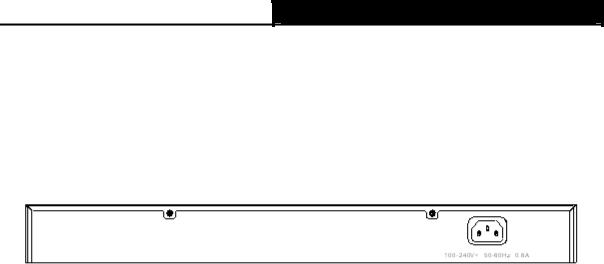
TL-R488T Load Balance Broadband Router User Guide
¾WAN: Four RJ45 port for connecting the router to a cable, DSL modem or Ethernet
¾LAN: One 10/100Mbps RJ45 port for connecting the router to the local PCs
2.1.2The Rear Panel
The rear panel of the TL-R488T only features a power receptacle, which is an AC power receptacle. Connect the female of the power cord head here, and the male head to the AC power outlet.
Figure 2-2
2.2System Requirements
¾Broadband Internet Access Service (DSL/Cable/Ethernet)
¾One DSL/Cable modem that has an RJ45 connector (It’s not necessary if you connect the router to Ethernet)
¾Each PC on the LAN needs a working Ethernet Adapter and an Ethernet cable with RJ45 connectors
¾TCP/IP protocol must be installed on each PC
¾Web browser, such as Microsoft Internet Explorer 5.0 or later, Netscape Navigator 6.0 or later
2.3Installation Environment Requirements
¾Not in direct sunlight or near a heater or heating vent
¾Not cluttered or crowded. There should be at least 2 inches (5 cm) of clear space on all sides of the router
¾Well ventilated (especially if it is in a closet)
¾Operating temperature: 0 ~40 (32 ~104 )
¾Operating Humidity: 10%~90%RH, Non-condensing
) Note:
Do not use this product near water, for example, in a wet basement or near a swimming pool. Avoid using this product during an electrical storm. There may be a remote risk of electric shock from lightning.
2.4Connecting the Router
Before you install the router, you should connect your PC to the Internet through your broadband service successfully. If there is any problem, please contact with your ISP for help. After that, please install the router according to the following steps. Don't forget to pull out the power plug and keep your hands dry.
5
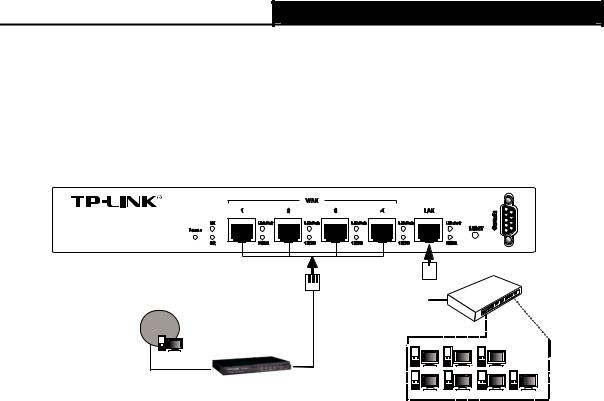
TL-R488T Load Balance Broadband Router User Guide
1.Power off your PC(s), Cable/DSL modem, and the router.
2.Connect the PC(s) and all Switches/Hubs on your LAN to the LAN Ports on the router, shown in Figure 2-3.
3.Connect the DSL/Cable modem to the WAN port on the router, shown in figure 3-1.
4.Connect the AC power adapter to the AC power socket on the router, and the other end into an electrical outlet. The router will start to work automatically.
5.Power on your PC(s) and Cable/DSL modem.
TLR488T
Quad-WAN Enterprise Broadband Router
To WAN |
|
|
|
To LAN |
||
|
|
|
||||
|
|
|
|
|
|
|
|
|
|
|
|
|
|
|
|
|
|
|
|
|
Switch/Hub
INTERNET
LAN
ISP
XDSL Cable Ethernet
Figure 2-3
6
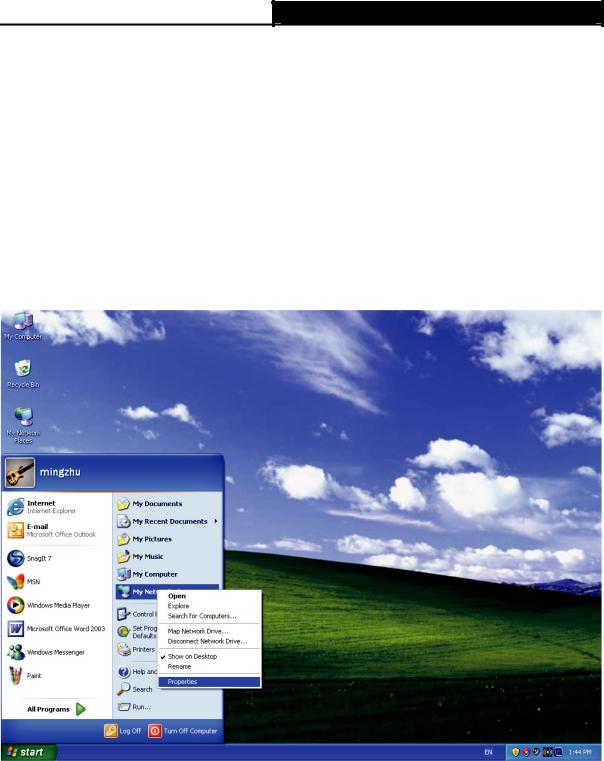
TL-R488T Load Balance Broadband Router User Guide
Chapter 3 Quick Installation Guide
After connecting the TL-R488T router into your network, you should configure it. This chapter describes how to configure the basic functions of your TL-R488T Load Balance Broadband Router. These procedures only take you a few minutes. You can access the Internet via the router immediately after it has been successfully configured.
3.1Configure PC
Step 1: Click the Start menu on your desktop, right click My Network Places, and then select Properties (shown in Figure 3-1).
Figure 3-1
Step 2: On the following screen, right click Local Area Connection (LAN), and then select
Properties.
7

TL-R488T Load Balance Broadband Router User Guide
Figure 3-2
Step 3: On the following screen, select General tab, highlight Internet Protocol (TCP/IP), and then click the Properties button.
8

TL-R488T Load Balance Broadband Router User Guide
Figure 3-3
Step 4: Configure the IP address as shown in Figure 3-4. After that, click OK.
9
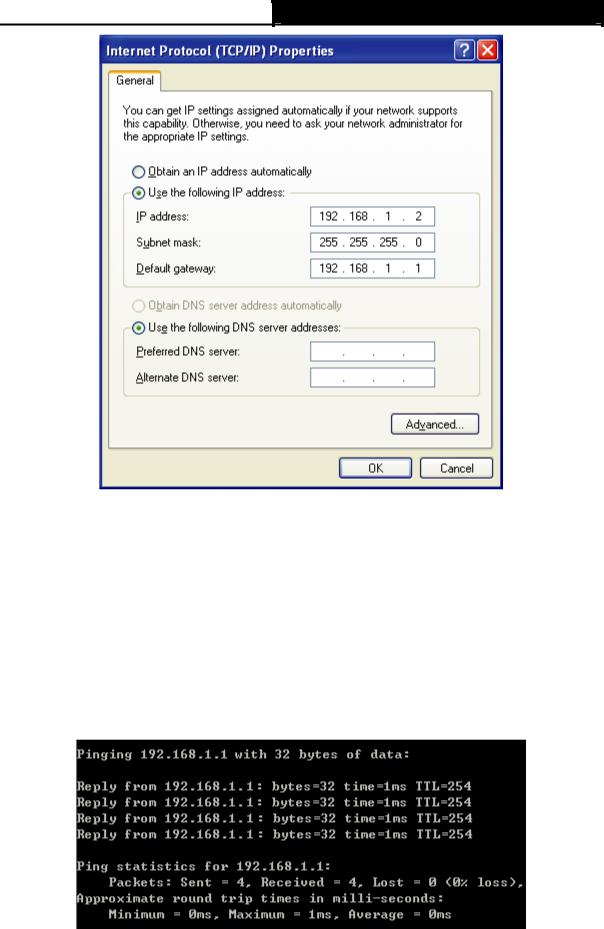
TL-R488T Load Balance Broadband Router User Guide
Figure 3-4
) Note:
You can select “Obtain an IP address automatically” and “Obtain DNS server address automatically” as shown above to get an IP address manually.
Now, you can run the Ping command in the command prompt to verify the network connection. Please click the Start menu on your desktop, select run tab, type cmd in the field, and then type ping 192.168.1.1 on the next screen, and then press Enter.
If the result displayed is similar to the screen below, the connection between your PC and the Router has been established.
Figure 3-5
10
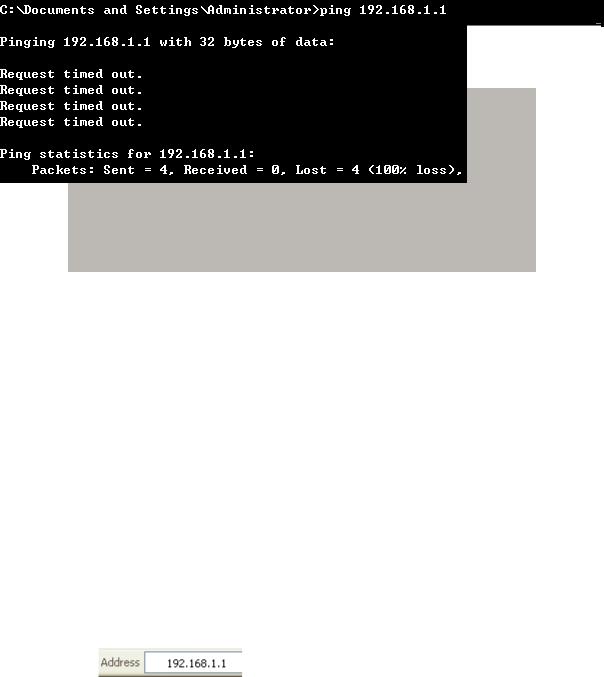
TL-R488T Load Balance Broadband Router User Guide
If the result displayed is similar to the screen as shown below, it means that your PC has not connected to the Router.
Figure 3-6
You can check it follow the steps below:
) Note:
Is the connection between your PC and the Router correct?
The LEDs of LAN port which you link to the device and the LEDs on your PC's adapter should be lit.
Is the TCP/IP configuration for your PC correct?
If the Router's IP address is 192.168.1.1, your PC's IP address must be within the range of 192.168.1.2 ~ 192.168.1.254.
3.2Login
Once your host PC is properly configured, please proceed as follows to use the Web-based Utility: Start your web browser and type the private IP address of the Router in the URL field:
192.168.1.1.
After that, you will see the screen as shown below, enter the default User Name admin and the default Password admin, and then click OK to access to the Quick Setup screen. You can follow the steps below to complete the Quick Setup.
11

TL-R488T Load Balance Broadband Router User Guide
Figure 3-7
) Note:
If the above screen (Figure 3-7) does not prompt, it means that your web-browser may be set to a proxy. Choose Tools menu→Internet Options→Connections→LAN Settings, in the screen that appears, cancel the Using Proxy checkbox, and click OK to finish it.
Step 1: Select the Quick Setup tab on the left of the main menu and the “Quick Setup” screen will appear. Click the Next button.
Figure 3-8
Step 2: Select the connection type to connect to the ISP and then click the Next button.
12
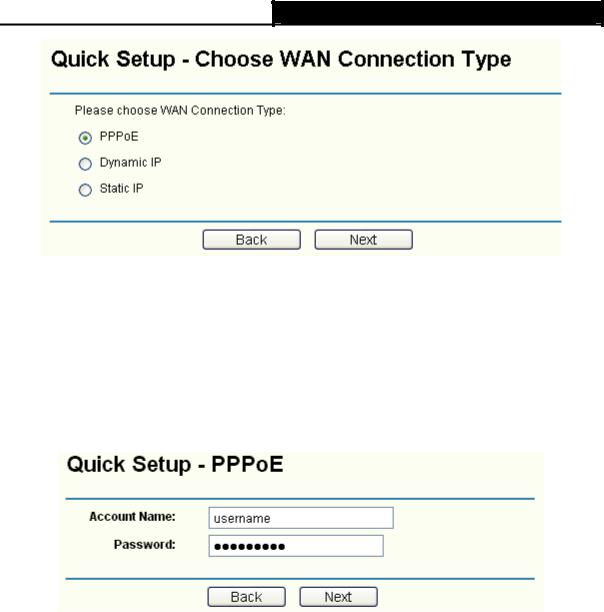
TL-R488T Load Balance Broadband Router User Guide
Figure 3-9
) Note:
The router supports three popular ways to connect to Internet. Please select one compatible with your ISP. If you are given another way not listed here, please refer to Network→ WAN for detailed list.
Step 3: If you choose PPPoE, you will see the screen as shown in Figure 3-10. Enter the Username and Password provided by your ISP. These fields are case sensitive. If you have difficulty with this process, please contact your ISP.
Figure 3-10
Step 4: If you choose Dynamic IP in Figure 3-9, the router will automatically receive the IP parameters from your ISP without needing to enter any parameters.
Step 5: If you Choose Static IP, you should enter the detailed IP information in Figure 3-11. Click the Next button
13
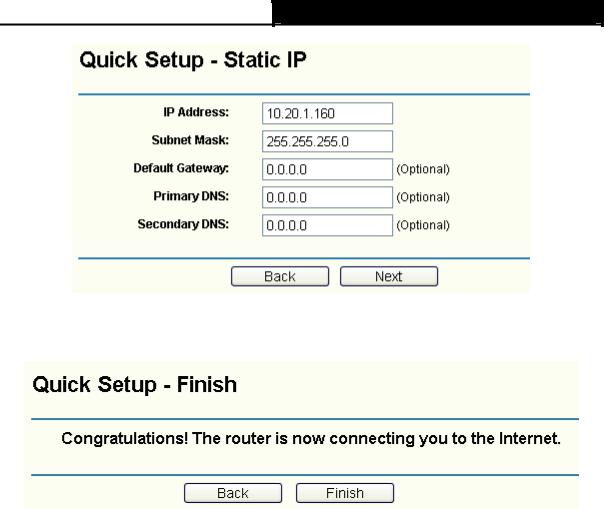
TL-R488T Load Balance Broadband Router User Guide
Figure 3-11
Step 6: After that, you will see the next screen. Click Finish to complete the quick installation.
Figure 3-12
14

TL-R488T Load Balance Broadband Router User Guide
Chapter 4 Configuring the Router
This User Guide recommends using the “Quick Installation Guide” for first-time installation. For advanced users, if you want to know more about this device and make use of its functions adequately, you need to read this chapter and configure advanced settings though the Web-based Utility.
After your successful login, you can configure and manage the router. There are main menus on the left of the Web-based Utility. Submenus will be available after you click one of the main menus. On the center of the web-based Utility, you can configure the function. Besides this, you can refer to the help on the right of the Web-based Utility. To apply any settings you have altered on the page, please click the Save button.
4.1Status
Choose “Status” menu, you can view the router's current status and configuration as shown in Figure 4-1. All information is read-only.
15
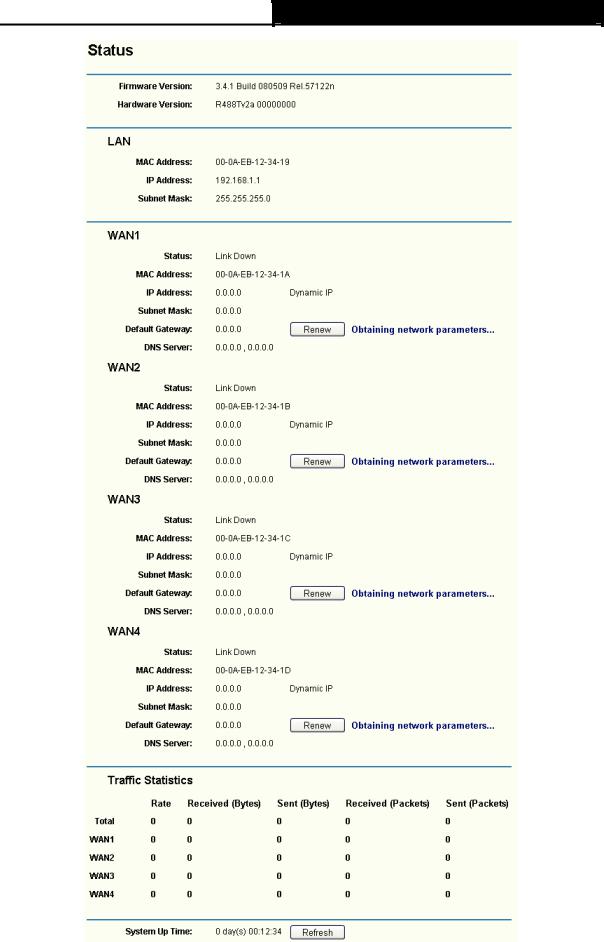
TL-R488T Load Balance Broadband Router User Guide
Figure 4-1
16
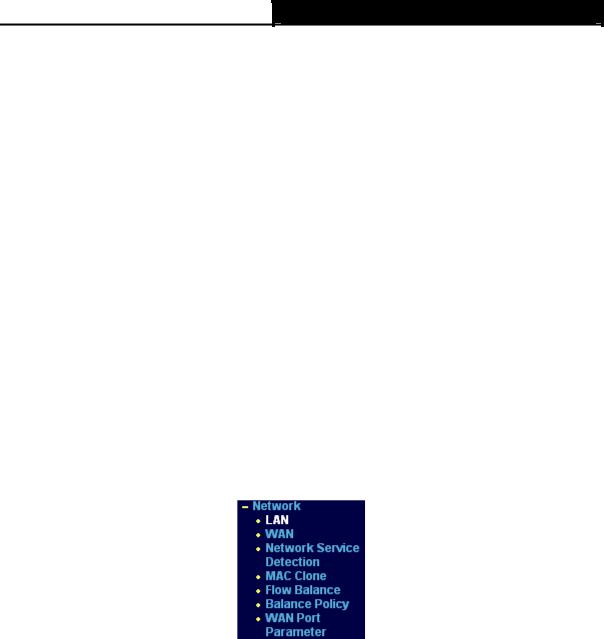
TL-R488T Load Balance Broadband Router User Guide
¾LAN - This field displays the current information for the LAN, including the “MAC address”, “IP address” and “Subnet Mask”.
¾WAN 1~4 - This field displays the parameters applied to the WAN ports of the router, including “MAC address”, “IP address”, “Subnet Mask”, “Default Gateway” and so on.
) Note:
If PPPoE/L2TP/PPTP is chosen as the WAN connection type, the Disconnect button will be shown here while you are accessing the Internet. You can also cut the connection by clicking the button. If you have not connected to the Internet, a Connect button will be shown, and you can click the button to establish the connection.
¾Traffic Statistics: This field displays the traffic statistics of WAN ports.
¾System Up Time: This field displays the time of the router running from the time it is powered on or is reset.
4.2Quick Setup
Please refer to chapter 3"Quick Installation Guide".
4.3Network
Choose menu “Network”, the next submenus are as shown below:
Figure 4-2
Click any of them, and you will be able to configure the corresponding function. The detailed explanations for each submenu are provided below.
4.3.1LAN
Choose menu “Network→LAN”, you can configure the IP parameters of the LAN on the screen below.
17
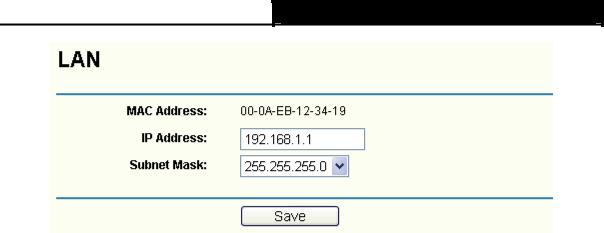
TL-R488T Load Balance Broadband Router User Guide
Figure 4-3
¾MAC Address - This field displays the physical address of the LAN. The value can't be changed.
¾IP Address - Enter the IP address for the LAN of the Router, the formal is in dotted-decimal notation (the factory default value is 192.168.1.1).
¾Subnet Mask - Enter the subnet mask for the LAN of the Router, this address code determines the size of the network. Normally use 255.255.255.0 as the subnet mask.
) Note:
1)If you change the IP address of the LAN, you must use the new IP address to login to the router.
2)If the new LAN IP Address you set is not in the same subnet, the IP Address pool in the DHCP sever will not take effect, until they are re-configured. Besides this, the Virtual Server and DMZ Host may change accordingly at the same time, and you’d better re-configure it as well.
4.3.2WAN
Choose menu “Network→WAN”, you can configure the IP parameters of the WAN on the screen below.
The Router provides three connection types for WAN to connect to the Internet, they are “Dynamic IP”, “Static IP” and “PPPoE”. For configuring the WAN, you should select the connection type firstly according your needs.
1.Dynamic IP
If you aren’t given any login parameters and IP information, please select Dynamic IP (shown in Figure 4-4), then the router will automatically get IP parameters from your ISP. Click the Renew button to renew the IP parameters from your ISP. Click the Release button to release the IP parameters.
18
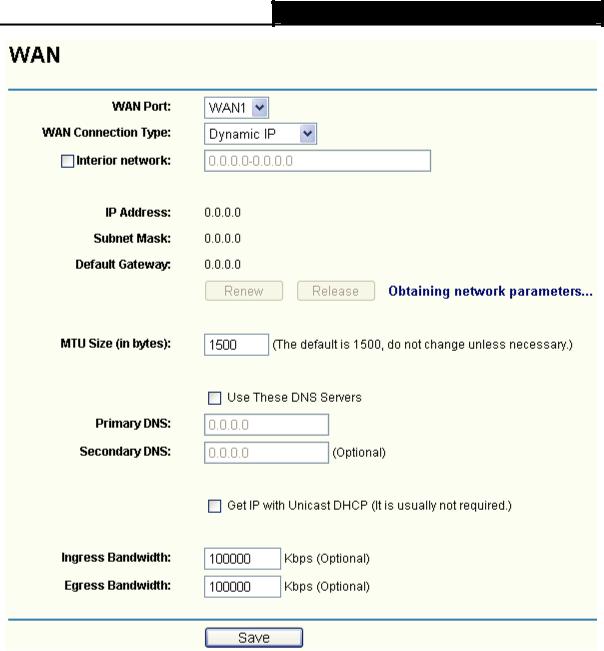
TL-R488T Load Balance Broadband Router User Guide
Figure 4-4
¾Interior network is: When the WAN is connecting with a LAN, you can select the option, and enter the LAN IP addresses in the field, then the WAN port will only transmit the traffic whose destination IP address are contained in the field.
¾MTU Size - The normal MTU (Maximum Transmission Unit) value for most Ethernet networks is 1500 Bytes. For some ISPs you need to reduce the MTU. But this is rarely required, and should not be done unless you are sure it is necessary for your ISP connection.
¾Primary DNS & Secondary DNS - If your ISP gives you one or two DNS addresses, select Use These DNS Servers and enter the primary and secondary addresses into the correct fields. Otherwise, the DNS servers will be assigned dynamically from ISP.
) Note:
If you get ‘Address not found' errors when you go to a Web site, it is likely that your DNS servers are set up improperly. You should contact your ISP to get correct DNS server.
19
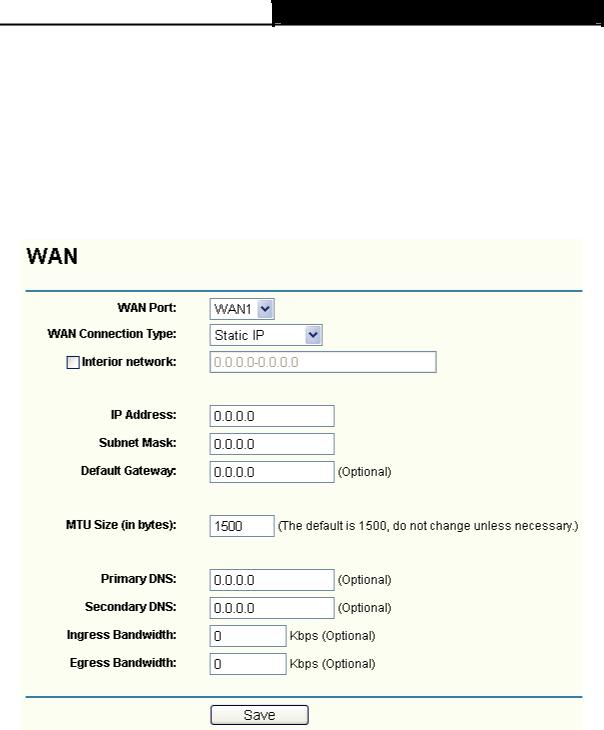
TL-R488T Load Balance Broadband Router User Guide
¾Get IP with Unicast DHCP: A few ISPs' DHCP servers do not support the broadcast applications. If you can not get the IP address normally, you can choose this option. (You don’t need select this option generally).
¾Ingress Bandwidth: Enter the bandwidth for ingress traffic.
¾Egress Bandwidth: Enter the bandwidth for egress traffic.
2.Static IP
If you are given a fixed IP (static IP), please select Static IP (shown in Figure 4-5), and then fixed IP parameters specified by your ISP.
Figure 4-5
¾IP Address - Enter the IP address in dotted-decimal notation provided by your ISP.
¾Subnet Mask - Enter the subnet Mask in dotted-decimal notation provided by your ISP, usually is 255.255.255.0.
¾Default Gateway - Enter the gateway IP address in dotted-decimal notation provided by your ISP (Optional).
¾MTU Size - The normal MTU (Maximum Transmission Unit) value for most Ethernet networks is 1500 Bytes. For some ISPs you may need to modify the MTU. But this is rarely required, and should not be done unless you are sure it is necessary for your ISP connection.
20

TL-R488T Load Balance Broadband Router User Guide
¾Primary DNS - Type the DNS address in dotted-decimal notation provided by your ISP (Optional).
¾Secondary DNS - Type another DNS address in dotted-decimal notation provided by your ISP if provided (Optional).
¾Ingress Bandwidth: Enter the bandwidth for ingress traffic.
¾Egress Bandwidth: Enter the bandwidth for egress traffic.
3.PPPoE
If you are given a user name and a password, please select PPPoE (shown in Figure 4-6). If you are not sure which connection type you use currently, please contact your ISP to obtain the correct information.
Figure 4-6
¾User Name/Password - Enter the User Name and Password provided by your ISP. These fields are case-sensitive.
¾Connect on Demand - You can configure the router to disconnect your Internet connection after a specified period of inactivity (Max Idle Time). If your Internet connection has been terminated due to inactivity, Connect on Demand enables the router to automatically re-establish your connection as soon as you attempt to access the Internet again. If you wish to activate Connect on Demand, click the radio button.
21

TL-R488T Load Balance Broadband Router User Guide
) Note:
1)If you want your Internet connection to remain active at all times, enter 0 in the Max Idle Time field. Otherwise, enter the number of minutes you want to have elapsed before your Internet connection terminates.
2)Sometimes the connection can not be disconnected although you specify a time to Max Idle Time. This is because there may still be active applications in the background, which may cause fee accounted by your ISP.
¾Connect Automatically - Connect automatically after the router is disconnected. To use this option, click the radio button.
¾Time-based Connecting - You can configure the router to make it connect or disconnect based on time. Enter the start time in HH:MM for connecting and end time in HH:MM for disconnecting in the Period of Time fields.
) Note:
Only you have set the system time on System Tools→Time screen, will the Time-based Connecting function take effect.
¾Connect Manually - You can configure the router to make it connect or disconnect manually. After a specified period of inactivity (Max Idle Time), the router will disconnect your Internet connection, and not be able to re-establish your connection automatically even though you attempt to access the Internet again. You need click the Connect button manually to connect immediately, or click the Disconnect button manually to disconnect immediately. To use this option, click the radio button. If you want your Internet connection to remain active at all times, enter 0 in the Max Idle Time field. Otherwise, enter the number in minutes that you wish to have the Internet connecting last unless a new link is requested.
) Note:
1)If you want your Internet connection to remain active at all times, enter 0 in the Max Idle Time field. Otherwise, enter the number in minutes that you wish to have the Internet connecting last unless a new link is requested.
2)Sometimes the connection cannot be disconnected although you specify a time to Max Idle Time. This is because there may still be active applications in the background, which may cause fee accounted by your ISP.
Click the Advanced button to set up the advanced option as shown in Figure 4-7.
22
